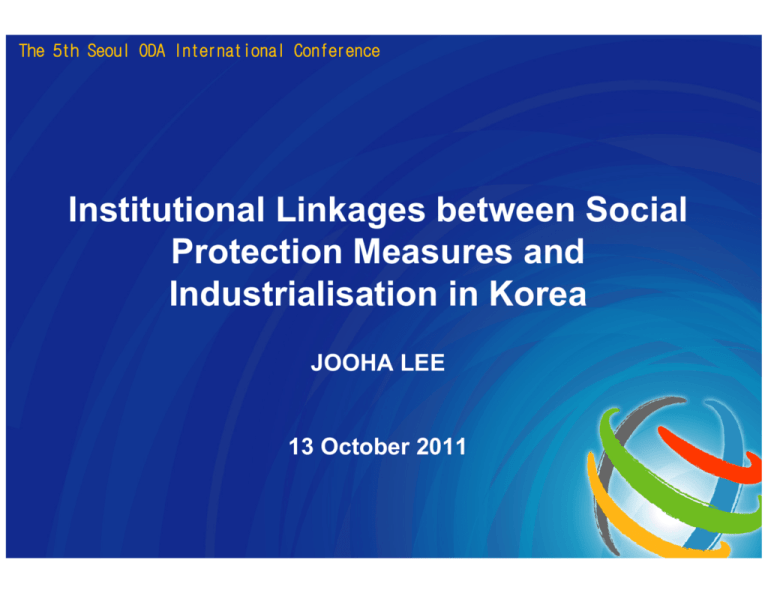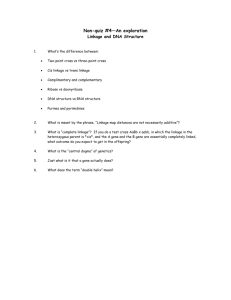PowerPoint ??????
advertisement

The 5th Seoul ODA International Conference Institutional Linkages between Social Protection Measures and Industrialisation in Korea JOOHA LEE 13 October 2011 Content • Compatibility between Economic Policy and Social Policy • Institutional Linkage between Economic Policy and Social Policy • Classifications of Institutional Linkage between Economic and Social Policies I. Compatibility between Economic Policy & Social Policy • Compatibility (positive-sum) or Incompatibility (trade-off) between efficiency/economic growth/capitalism & equity/egalitarian redistribution/welfare state • After the golden age, new incompatibility: social policy Æ decline in productive sector labour supply & work incentive (i) (ii) (iii) saving & investment • Empirical evidence of trade-off arguments Æ mixed and inconclusive (e.g. Atkinson 1999) • Globalisation and social policy: compensation effect (Rodrick 1997) & compatibility effect (Gough 1996) • Reciprocal, complex and dynamic relationship b/w social & economic policies II. Institutional Linkage between Economic Policy & Social Policy • The Developmental State & Developmental Welfare - The state’s role as a regulator & a low social spender - Prominent welfare role of the private sector - initiated & advocated by bipartite coalitions Æ ‘Varieties of Capitalism’ approach II-1. Institutional Linkage at the Regime Level • Varieties of Capitalism approach (e.g. Soskice 1999; Hall and Soskice 2001; Ebbinghaus and Manow 2001) - Institutional complementarities (or elective affinities) b/w specific social protection and particular components of production regimes (a) Liberal Market Economies (LMEs) (b) Coordinated Market Economies (CMEs) (cont.) Industry-based coordination (Europe) & Group-based coordination (Japan, Korea) • Group-coordinated market economies - state-business alliance - vocational training as a company-based phenomenon - technology diffusion and development within the group of companies - company-based unions II-2. Institutional Linkage at the Policy Level • Social policy under group-CME: company welfare (& company-specific skill) Æ institutionally complementary to other spheres of production regime (i.e. industrial relations, vocational training, corporate governance) • ‘Economy-first’ developmental strategy and its subordination of social welfare • Linkage b/w work and welfare in terms of (i) employment (by the high economic growth rate and rising income levels); (ii) human capital investment (also self-reliance); (iii) company welfare (with lifelong employment patterns); (iv) work-based, contributory social insurance programmes III. Classifications of Institutional Linkage Production Economic Infrastructure Tax Credit Reproduction (Supply-side) Redistribution (Demand-side) Social Investment Cash Transfer Protection III-1. Social Investment • Swedish ‘active manpower policy’, the US ‘workfare’, the UK ‘welfare-to-work’ • East Asian productivist social policy • Korean social investment & Industrialisation - Low spending on ALMP (0.1% of GDP in 1996) - High spending on education (17.6% of gov’t expenditure in 1972, 21% in 1983, 19.8% in 1987) Æ High participation and completion rates at all levels of formal education - state-led vocational training system during 1970s III-2. Economic Infrastructure • Infra (transport, energy, information/communication technology, drinking water, sanitation and irrigation) Æ economic growth (raising labour productivity and lowering production and transaction costs) & reproduction of labour force (improving health, nutrition and education) • Expanding infrastructure in the early stage of development <e.g.> Transport infrastructure (expressways, urban railways, container ports) III-3. Tax Credit • Fiscal welfare (Titmuss 1958) • Tax expenditure: relieving tax burdens or giving tax refunds to individuals for social purposes • Tax incentives and exemptions for firms • A series of tax bills during the industrialisation period Æ to encourage firms’ investment and individuals’ saving • Cash transfers Æ not a main policy tool before 1997








